The scientific use given to Google Earth in geography and geology matters is becoming increasingly interesting, even though we, from the cadastral point of view, criticized so much its precision for our selfish ends.
Some time ago I talked about the existence of an animated tectonic evolution map through the continental drift’s theory. The United States Geological Service (USGS) in partnership with Google has created a layer in which you can view the different tectonic plates that make up our planet’s lithosphere. It’s too much educational for a post, but I’ll try to keep the simplicity that requires 700 words of my visitors’ patience and also inspired in a new blog I’ve discovered today called todocartografía (all cartography).
1. The plates
At least 15 major plates are recognized:
| In our Spanish-speaking environment these are related to us:
North America, from Guatemala to the pole is the North American plate, coinciding in the Pacific with the Pacific plate and the small Juan de Fuca’s Plate. Central America there is the Caribbean plate and the Cocos plate, which is toward the Pacific Ocean. South America, there are South American plates, Scottish and Nazca. Far south of Chile is some contact with the Antarctic plate. Spain is on the Eurasian plate, which sticks with the African plate. |
|
So in our Hispanic environment, we have relationship with 11 of the 15 plates. The map below shows these layers painted as school’s style.
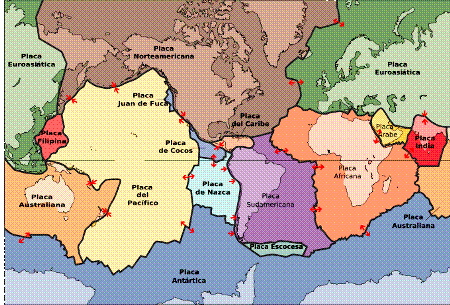
2. The displacement
The flow of boiling lava beneath the surface causes the plates to have a displacement which is approximately 2.5 cm per year, (the rate at which fingernails grow) in the map are shown arrows which indicate the direction. This separation or approach is not so much, but it is considerable if we think how much a point has moved in 30 years, it would be about 75 centimeters. If we think a point in Mexico, moving about 75 cm to the west and in the Greenwich meridian which moves in the opposite direction, it would be 1.50 meters in total. The point is that the plates move, but the mesh created for the latitudes and longitudes do not change; so this means that a point is moving with respect to its coordinate system.
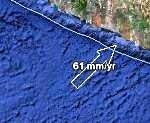 As a result, the same point, measured under the same conditions, within 30 years would be moved 75 centimeters. The Google Earth map shows the movement and direction of the plates in different areas.
As a result, the same point, measured under the same conditions, within 30 years would be moved 75 centimeters. The Google Earth map shows the movement and direction of the plates in different areas.
This is one of the reasons why the survey is tied to checkpoints, which maintains the relative reference for subsequent cadastral surveying with respect to the geodesic vertexes. Finally we realize that our gps’ ultra precision is quite relative to the exaggerated attention we provide to them.
3. Geological faults
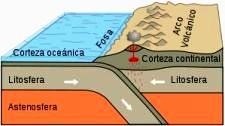 The rub or slide between these plates is what has also formed mountain ranges, this is what it also causes earthquakes or volcanic activity. At least three relationships between the plates shall be considered:
The rub or slide between these plates is what has also formed mountain ranges, this is what it also causes earthquakes or volcanic activity. At least three relationships between the plates shall be considered:
- Convergent (Collide between them)
- Divergent (they are separating each other)
- Transformants (they slide together)
Meanwhile, the boundaries between plates can be:
- Constructive
- Destructive
- Conservative
Google’s map shows this situation in different colors.
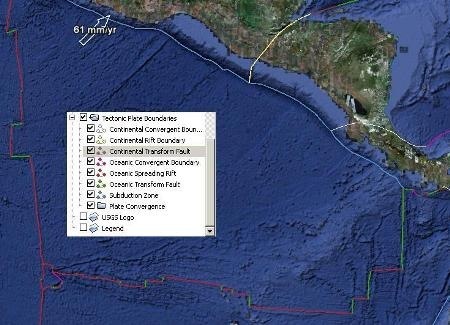
The map also includes an earthquakes layer, it is assumed in real time, showing the magnitude and themed date.
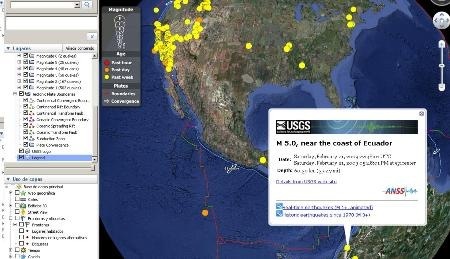
The best benefit from this kind of Google Earth features are educators, mainly those who teach social studies, geography and geology… undoubtedly, Google Earth has changed the way we see the sphere.
 Autocad Software, Bentley Microstation, Gis Google Earth, Gis System Geomate Provides Services For Complete Gis Software And Solutions, Autocad Software, Autocad Courses, Bentley Microstation, Microstation Software, Gis Google Earth, Open Source Gis And More.
Autocad Software, Bentley Microstation, Gis Google Earth, Gis System Geomate Provides Services For Complete Gis Software And Solutions, Autocad Software, Autocad Courses, Bentley Microstation, Microstation Software, Gis Google Earth, Open Source Gis And More.